With more people using ChatGPT to search online, brands may be looking to build presence in this space. But use-rate alone shouldn’t dictate how ChatGPT falls into your marketing strategy. As with any other channel, knowing who’s using it is crucial to making it work for your brand.
In this post, we explore the demographics of ChatGPT users, helping you assess the commercial viability of your brand’s presence on the platform and identify where the biggest opportunities lie.
TL;DR: ChatGPT users at a glance (2025)
- Age: 18–34 dominate (≈55%), but 45+ users make up over a quarter of the base.
- Gender: Slight male majority (≈55%), but usage interests differ by gender.
- Education: Highly educated users engage most, particularly for work-related queries.
- Income & profession: Mid-to-high earners and those in management roles are frequent users.
- Device Use: 61% of sessions are mobile; app is preferred (48% of mobile users). Desktop peaks during work hours.
- Geography (UK): Highest usage in London, Manchester, Newcastle; lowest in Inverness and smaller post-industrial cities.
- Use context: Younger users skew personal/academic; older users skew work-focused.
- Industry: In the UK, ChatGPT is used most across advertising, legal, and arts & media roles.
ChatGPT user demographics
ChatGPT users are a relatively diverse bunch, with some fairly even weighting across top-level demographic points like gender. However, more specific audience segments are starting to stand out, offering stronger clues as to whether your target market is active on the platform.
What age are ChatGPT users?
ChatGPT users skew young, but given the platform’s massive monthly traffic, even lower-share age groups may represent a large number of users.
The majority of ChatGPT users are between the ages of 18 and 34, accounting for just shy of 55% of the total user base, and over 45% of ChatGPT users are 25 years old or younger(1).
Unsurprisingly, ChatGPT use decreases with age, but not as exponentially as you might think.

- People age 65 and older make up 5.18% of users, which equals over 41 million people.
- Users between 55 and 64 make up 8.81%, or nearly 70.5 million people.
Together, adults age 45 and up account for over a quarter of all ChatGPT users, almost as many as the platform's largest single-range age group — those between 25 and 34.
This means that while ChatGPT is great for reaching younger audiences, brands targeting older demographics shouldn’t disregard it entirely. Reaching different segments of older generations, however, may require careful strategy to align your content with how each group tends to use the platform.
According to an OpenAI study, the likelihood of a ChatGPT interaction being work-related differs by age range, with 36-45s sending the most work-oriented messages, followed closely by 46-55s and 26-35s, then not quite so closely by 56-65s, 18-25s, and 66+. In light of this, professional and productivity-focused positioning will be most effective for mid-career users, while lifestyle and personal-use angles resonate more with both younger and older groups. For seniors past retirement, practical, everyday or enrichment-focused content is perhaps most likely to be cited.

Source: OpenAI/National Bureau of Economic Research
Are ChatGPT users mostly male or female?
The majority of ChatGPT users are male, but it’s a small majority.
As it stands, the gender split of ChatGPT users is:
- 54.69% male
- 45.31% female
That’s less than 10% difference!
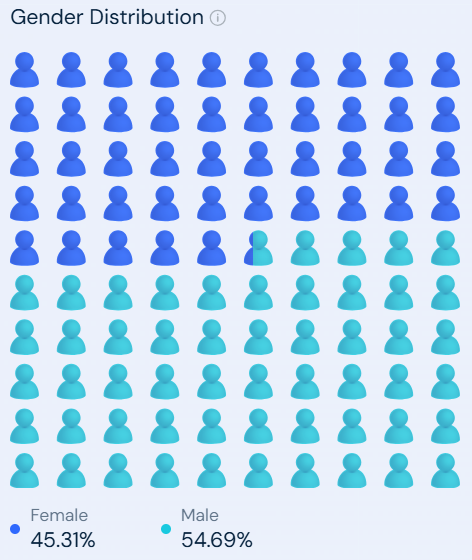
Source: Similarweb
So, whether gender plays a significant role in your targeting or not, ChatGPT could be a good place to build visibility.
Interestingly, a recent OpenAI study on ChatGPT use revealed that, although the gender divide among users is narrowing, male and female users tend to turn to ChatGPT for different things.
During data analysis, researchers noticed that users with typically feminine names were more likely to use ChatGPT as a writing tool or for practical guidance. Users with typically masculine names, on the other hand, were more likely to use ChatGPT for technical or multimedia assistance.
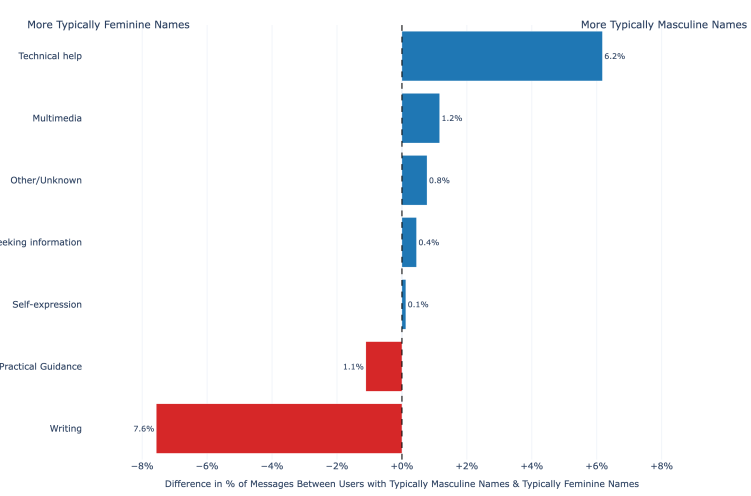
Source: OpenAI/National Bureau of Economic Research
Education level of ChatGPT users
US research suggests people with degrees account for the highest ChatGPT use rates by education level(2), and those with post graduate degrees are particularly inclined to use the platform(3).
Recently published data from OpenAI supports these assertions, also shedding light on how each main education stage uses ChatGPT. For example, the more educated a user is, the more likely they are to type work-related messages into ChatGPT:
- Users with no bachelors degree = 37% of messages sent are work-related
- Users with a bachelors degree = 46% of messages sent are work-related
- Users with post graduate education = 48% of messages sent are work-related
That said, there are limited differences between query intent and conversation topics by education range — although writing is a marginally more common subject the more educated a user is.
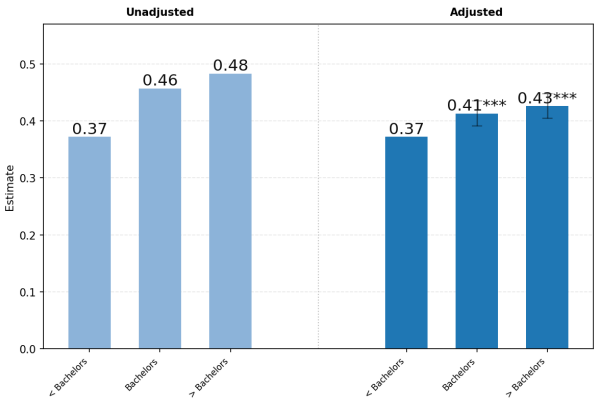
Source: OpenAI/National Bureau of Economic Research
ChatGPT is also popular among undergrad students, who use it primarily as a research assistant and to help with drafting essays.
Does ChatGPT plagiarise? We put it to the test! Explore our findings.
A 2025 hepi survey involving 1,041 full-time undergraduate students suggests almost all undergraduate students are using AI in some form in 2025, rising to 92% from 2024’s 66%.
While the survey doesn’t say which AI tools respondents were using, as the most popular AI platform overall (see the below market share chart) and the go-to for planning content, it’s safe to assume that ChatGPT was top of the list, perhaps followed closely by the more academia-leaning Perplexity.
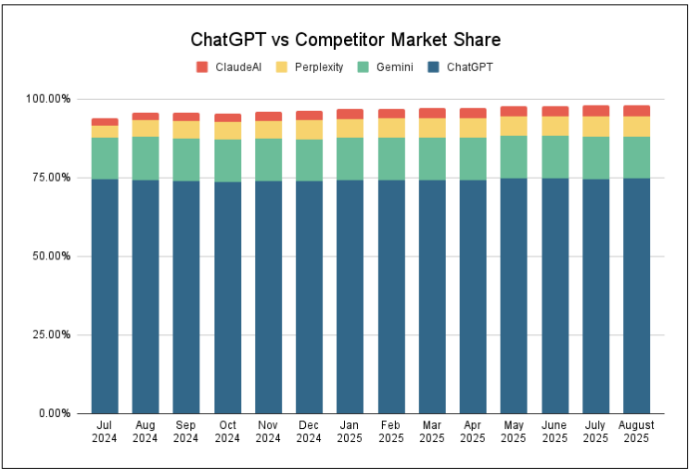
Source: Firstpageseo
What’s more, research shows students who begin using ChatGPT for academic purposes may also start using it more broadly for personal search purposes, making them a valuable target audience for a variety of brands.
ChatGPT user income brackets
ChatGPT users span most income ranges, but with the majority being highly educated, mid-career professionals, use rate is higher for mid-to-high salary brackets.
Global information is limited on this front, but according to Business.com research, in the US, those with salaries of $70,000 or above are more likely to use ChatGPT. This research also revealed that upper management employees rack up three times the use rate of non managers.
ChatGPT use rate by industry
ChatGPT is used more regularly within certain industries. OpenAI’s data gives us an insight into the split between very general work categories, showing (predictably) that computer-related professions have the highest use-rates, followed by users with jobs in the “management/business” and “engineering” categories.
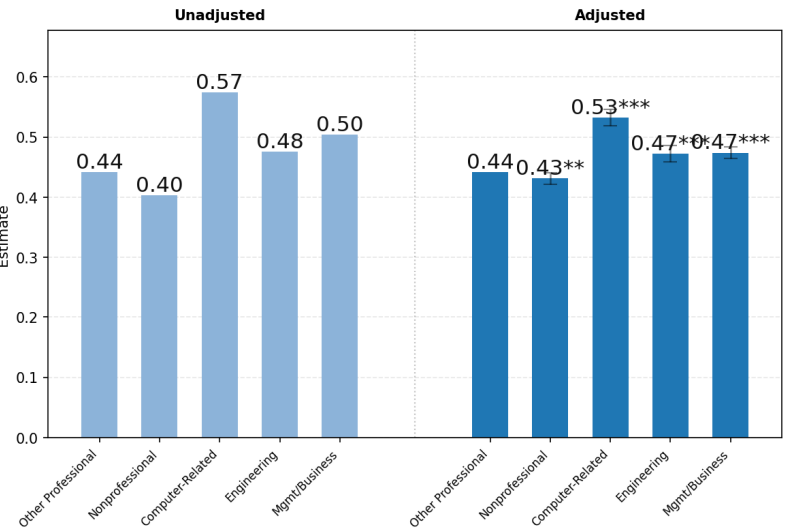
Source: OpenAI/National Bureau of Economic Research
Research from other sources provides a more nuanced insight into how ChatGPT is being used across different industries.
For instance, the below table shows a breakdown of industries in which ChatGPT is used as part of their purchasing journey:
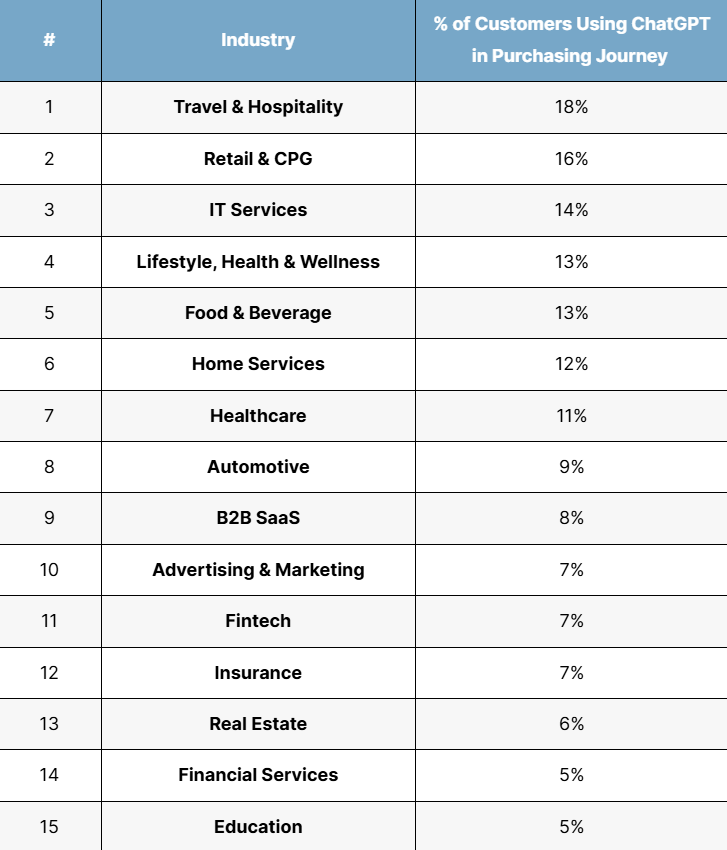
Source: Firstpagesage
For general usage among UK businesses specifically, the most recent available data is from a 2023 Indusface survey of 2000 workers across various job levels and sectors:
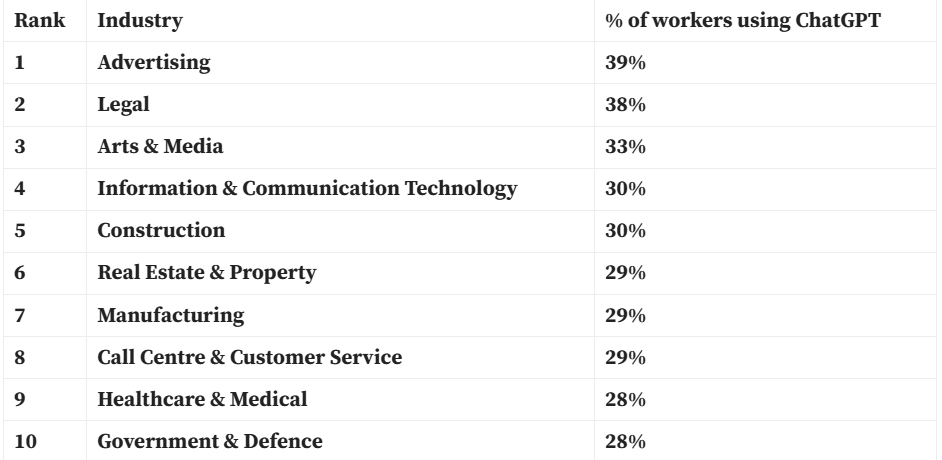
Source Workplacewellbeing
While some of the high-placing industries (such as advertising and legal) are predictable, others (such as construction, real estate, manufacturing, and healthcare) highlight just how broadly ChatGPT is being used.
Device preferences of ChatGPT users
In 2025, most ChatGPT sessions happen on the go, with 61% of users accessing it from mobile devices, compared to 39% on desktop(4).
Nearly half of mobile users (48%) favour the dedicated app, while just 13% rely on a mobile browser. Desktop use is highest during working hours, while mobile peaks in the evening, from 7pm to 10pm.
UK ChatGPT users - what we know so far
Since the UK ranks only 5th in ChatGPT usage globally (with the US, India, and Brazil leading the pack), more often than not, research focuses elsewhere.
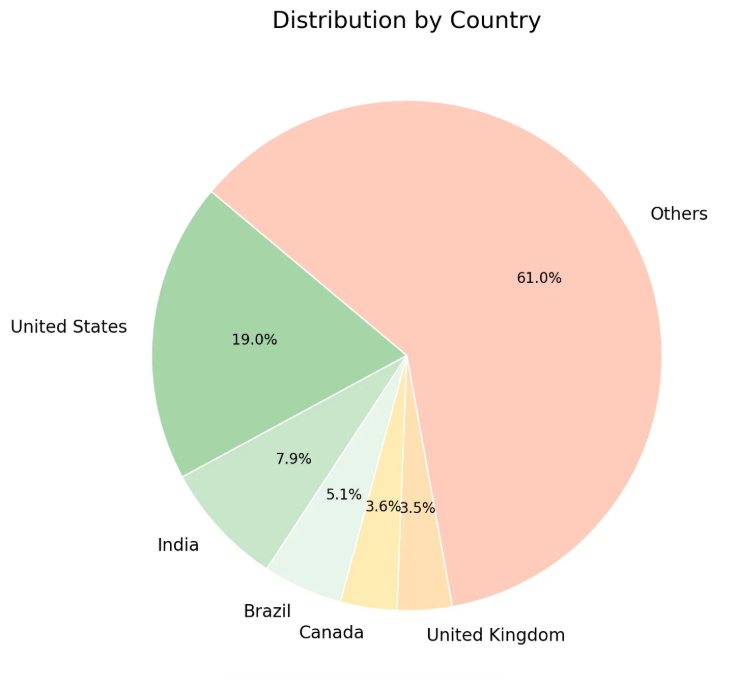
Source: Nerdynav
However, there are some UK-specific data points arising, giving some great insight into domestic ChatGPT user demographics.
Here’s what we know so far:
- ChatGPT use is generally growing in the UK - 1 in 5 people active on the internet in the UK claim to use ChatGPT.
- Londoners use ChatGPT the most - According to Ipsos data, 30% of all Londoners used ChatGPT in February 2025. Based on the current estimated population of London, that’s just shy of 3 million users in one city!
- Young Londoners are especially keen – Within the London user base, usage jumps to 57% for those between the ages 15-25.
- The gender split mirrors that seen in the US and globally - In the UK, the majority of ChatGPT users are male, but it’s a small majority. Plus, the Ipsos research suggests the female user base is growing faster than the male.
- Adjusted for population size, people in Manchester are the most interested in ChatGPT in the UK - Based on Ramsac research, per 1000 people, Manchester leads the way in ChatGPT interest — and potentially usage. Newcastle places second, Birmingham takes the bronze, and London lands in fourth place.
- ChatGPT interest in the UK is lowest in Inverness - The above-mentioned research also highlights the UK cities with the lowest interest in ChatGPT (based on searches). Inverness is the least interested, followed by Newport, Londonderry, and York.
- High- and low-interest zones highlight the digital divide – Cities surfaced by research as having the least ChatGPT interest tend to be smaller, older, or more post-industrial. In contrast, the highest-interest cities are larger, younger, and more knowledge-driven, suggesting that adoption maps closely onto the UK’s broader economic and demographic divides.
- ChatGPT is likely most popular among Gen Z and Millennials - According to Ofcom’s May 2025 Adults’ Media Use and Attitudes report, AI is most popular among two age ranges in the UK:
- 16-24 (53%)
- 25-34 (48%)
So, is ChatGPT the place to be?
As AI search isn’t going anywhere, we at TDMP feel it’s essential for all brands to seriously consider how these platforms fit into their marketing strategy. But based on demographic and sector dynamics, for some businesses the commercial stakes are higher, so the need is more urgent.
Here are the main takeaways:
- Brands targeting high-value professionals - Mid-to-high income earners and managers use ChatGPT for work and decision-making. If your brand needs to reach these key decision-makers, ChatGPT should factor into your marketing strategy.
- Brands targeting less defined, older generations - Together, people over the age of 45 make up roughly 25% of ChatGPT users. So, for brands with a typically older target audience, perhaps in the private healthcare space, ChatGPT is a good place to be visible.
- Brands with young target audiences - As ChatGPT is most popular among younger generations, brands with offerings geared towards these age groups should seriously consider how to build their presence on the platform.
- Brands in education and learning - From undergraduates to lifelong learners, ChatGPT is widely used as a research and writing tool. If your brand supports study, skills, or personal development, visibility here aligns with natural user behaviour.
Comprehensive digital marketing support from TDMP
At TDMP, we’ve been integrating AI visibility optimisation into our core SEO services for years — helping our clients not just survive, but thrive as AI search continues to grow. If you’re unsure how ChatGPT and other AI platforms fit into your marketing strategy, let’s talk.
Citations
- ExplodingTopics: Number of ChatGPT Users
- DigitalSilk: Number of ChatGPT Users in 2025: Stats, Usage and Impact
- Statista: Knowledge of ChatGPT by Education in US
- ZebraCat: 150+ChatGPT Usage Statistics (2025)

